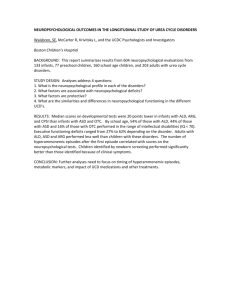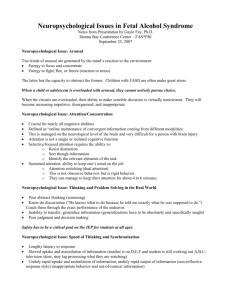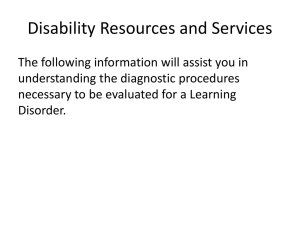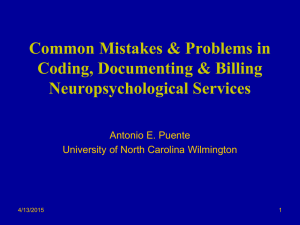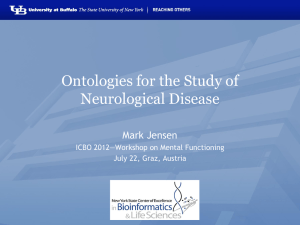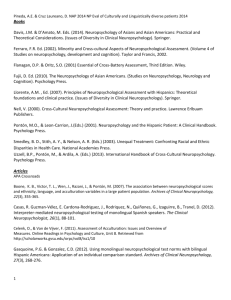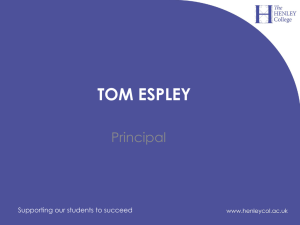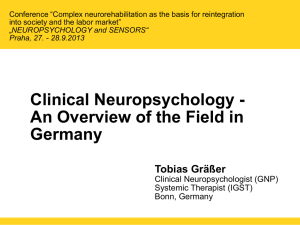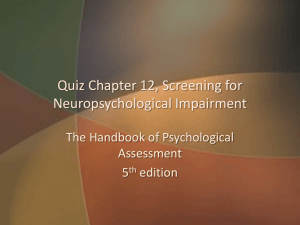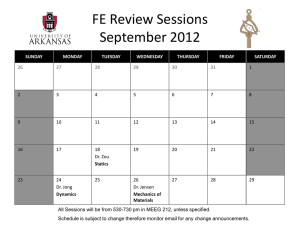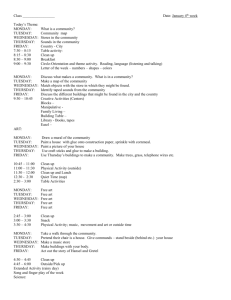EdPsy 471 Educational Neuropsychology
advertisement
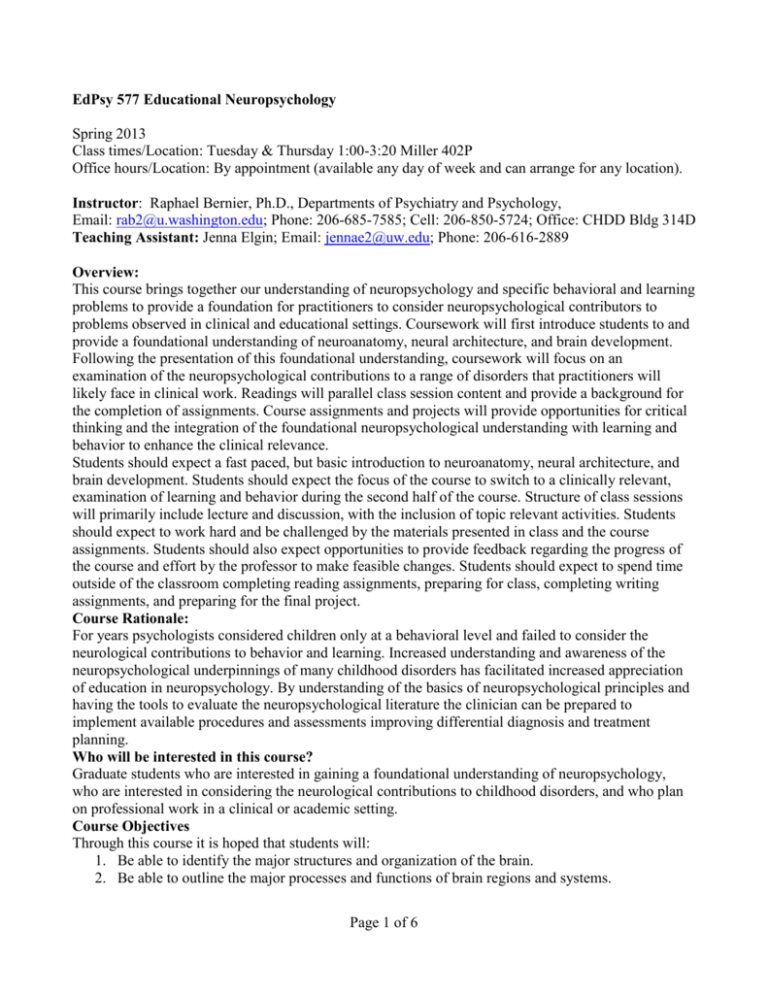
EdPsy 577 Educational Neuropsychology Spring 2013 Class times/Location: Tuesday & Thursday 1:00-3:20 Miller 402P Office hours/Location: By appointment (available any day of week and can arrange for any location). Instructor: Raphael Bernier, Ph.D., Departments of Psychiatry and Psychology, Email: rab2@u.washington.edu; Phone: 206-685-7585; Cell: 206-850-5724; Office: CHDD Bldg 314D Teaching Assistant: Jenna Elgin; Email: jennae2@uw.edu; Phone: 206-616-2889 Overview: This course brings together our understanding of neuropsychology and specific behavioral and learning problems to provide a foundation for practitioners to consider neuropsychological contributors to problems observed in clinical and educational settings. Coursework will first introduce students to and provide a foundational understanding of neuroanatomy, neural architecture, and brain development. Following the presentation of this foundational understanding, coursework will focus on an examination of the neuropsychological contributions to a range of disorders that practitioners will likely face in clinical work. Readings will parallel class session content and provide a background for the completion of assignments. Course assignments and projects will provide opportunities for critical thinking and the integration of the foundational neuropsychological understanding with learning and behavior to enhance the clinical relevance. Students should expect a fast paced, but basic introduction to neuroanatomy, neural architecture, and brain development. Students should expect the focus of the course to switch to a clinically relevant, examination of learning and behavior during the second half of the course. Structure of class sessions will primarily include lecture and discussion, with the inclusion of topic relevant activities. Students should expect to work hard and be challenged by the materials presented in class and the course assignments. Students should also expect opportunities to provide feedback regarding the progress of the course and effort by the professor to make feasible changes. Students should expect to spend time outside of the classroom completing reading assignments, preparing for class, completing writing assignments, and preparing for the final project. Course Rationale: For years psychologists considered children only at a behavioral level and failed to consider the neurological contributions to behavior and learning. Increased understanding and awareness of the neuropsychological underpinnings of many childhood disorders has facilitated increased appreciation of education in neuropsychology. By understanding of the basics of neuropsychological principles and having the tools to evaluate the neuropsychological literature the clinician can be prepared to implement available procedures and assessments improving differential diagnosis and treatment planning. Who will be interested in this course? Graduate students who are interested in gaining a foundational understanding of neuropsychology, who are interested in considering the neurological contributions to childhood disorders, and who plan on professional work in a clinical or academic setting. Course Objectives Through this course it is hoped that students will: 1. Be able to identify the major structures and organization of the brain. 2. Be able to outline the major processes and functions of brain regions and systems. Page 1 of 6 3. Be able to identify the neurological contributions to common childhood disorders that clinicians will face in professional work. 4. Acquire the critical thinking skills to link neurological function and dysfunction to behavior. 5. Sharpen critical thinking and professional communication skills through an evaluation of the neuroscience literature. Course Structure The course will be organized into two primary content areas: fundamentals of neuropsychology and examination of neurological contributions to childhood disorders. The course will consist of classroom meetings twice weekly for 2.5 hours with a break halfway through each class. The course instructor will be available weekly during office hours and by email and phone for consultation at any time during the workweek. The first four classes will be lecture based and then will move to a more discussion based format. Course Expectations, Requirements, and Grading Required Texts: 1. Kolb, & Whishaw (2008). Fundamentals of human neuropsychology, 6th Edition. New York: Worth Publishers, Inc., ISBN13: 9780716795865. 2. Additional readings will be provided as pdfs at the instructor’s course webpage: http://faculty.washington.edu/rab2/EdPsy577.html. 3. Recommended text: Diamond, Scheibel, & Elson (1985). The Human Brain Coloring Book. New York: Harper Perennial, ISBN:0064603067. Course Requirements 1. Participation. Attendance, participation and preparedness for all classes is mandatory. Attendance, timeliness, and participation consist of coming to class prepared, having completed any reading assignments, being ready for discussion, and active listening or participation in discussion. Reading assignments are to be completed before class on the day they appear on the schedule. For each reading assignment, prepare one question/comment about how the reading relates to child development, learning, or psychopathology. These questions will serve as the foundation for class discussions. If you have markers/colored pencils/crayons bring along to class to share for activities. Course participation will be evaluated according to the rubric outlined on page 5 of this syllabus. 2. Mid-term, open-book quiz. The acquisition of new vocabulary and concepts related to neuropsychology (e.g., nomenclature for naming brain regions; visual-spatial representations of neural architecture; and general principles of the structural and functional organization of the brain) is a course objective. The open-book, take home quiz will assess knowledge of brain geography (brain structures, locations, and names), general principles of brain development, and functional organization of the brain through direct questions regarding covered topics and through analytic examination of clinical vignettes in a multiple choice type format. 3. Literature Evaluation Project: paper and oral presentation. To demonstrate proficiency of critical thinking and professional communication skills in relation to the neuroscience literature, choose five published, peer reviewed neuropsychological (e.g. neurophysiology, imaging, behavioral neuropsych) studies related to a disorder or topic of interest to you. Submit the topic area and list of studies to the instructor for approval. Write a scholarly paper demonstrating your ability to apply knowledge learned in the course to describing, understanding, and critiquing the research articles (Paper length should be approximately 10 double spaced pages and is due on May 30. Make a 10-15 minute, communicative and professional, yet entertaining, oral presentation on your evaluation of the studies to class (Presentations will be on May 30 and June 6). This can be done with a partner, but the study list, length of paper, and presentation should be doubled in length. Page 2 of 6 4. Clinical Review Papers. To demonstrate critical thinking skills in integrating neurological function and dysfunction to behavior the completion of two brief writing assignments is required. 1. For the first, please describe the possible neurological contributions based on a clinical case presentation. See attached clinical presentation. 2. For the second, describe the possible clinical presentation based on the described neurological findings for a particular case. See attached clinical presentation. There are no right and wrong answers for this assignment. The goal is to assess your ability to integrate the foundational neuroscience knowledge and typical and atypical behavior. Both papers should be between 1 and 2 pages double-spaced in length and are due June 6 or can be submitted any time prior. 5. Neuropsychological Report Commentary. To provide a clinically relevant opportunity for critical thinking regarding neuropsychological and diagnostic reports that you are likely to encounter in your clinical and educational setting, your evaluation and commentary regarding the quality of two neuropsychological/diagnostic reports is required. Each report will have areas of strengths and weaknesses. In the short commentary and critique (between 1 and 2 pages double-spaced in length for each report) you are to identify and critique the areas of weaknesses present in the sample reports, integrating knowledge gained over the course of the quarter regarding brain functioning and psychological disorders. The commentary is due May 23. Grading: This course is graded credit/no credit. Grading is based on the following requirements: (a) overall score on the in class exam which assesses factual knowledge and inferential thinking (25% of grade); (b) quality of clinical review papers translating knowledge into practice (20% of grade); (c) quality of written literature evaluation project paper and oral presentation (20% of grade); (d) attendance and participation in class (25% of grade); and (e) observation and commentary (10% of grade). Accommodations for Disability: If you would like to request academic accommodations due to a disability, please contact Disabled Students Services, 448 Schmitz Hall, (206) 543-8924. If you have a letter from Disabled Student Services indicating that you have a disability that requires accommodations, please meet with me to discuss the accommodation you might need for class. Plagiarism: Plagiarism, submitting someone else's words or ideas as your own work, is a serious academic offense. Cases of suspected plagiarism will be referred to the Associate Dean for Academic Programs for adjudication. Possible penalties range from disciplinary warnings to dismissal from the university. All students are expected to demonstrate academic integrity at all times, and to learn what constitutes plagiarism. A useful definition of plagiarism can be found at: http://depts.washington.edu/grading/issue1/honesty.htm#plagiarism Schedule for Class Meetings and Out of Class Assignments: Date & Class # Topic Tuesday, April 2 Class #1 Thursday, April 4 Class #2 Tuesday, April 9 Class #3 Thursday, April 11 Class #4 Reading Assignments and Due Dates Course Overview Gross Anatomy & CNS Organization; Chapter 3 (p51-81) Neuronal structure and communication Chapters 4-5 (p82131) Chapters 13-14 (skim these) Cortical structure and function Page 3 of 6 Tuesday, April 16 Class #5 Thursday, April 18 Class #6 Tuesday, April 23 Class #7 Cortical structure and function Thursday, April 25 Class #8 High Order Cortical functions; Quality of Neuropsychological Evals; Respond to feedback Tuesday, April 30 Class #9 Brain Development and related disorders Neuroimaging Techniques Thursday, May 2 Class #10 Drugs, hormones, psychopharmacology, substance abuse Tuesday, May 7 Class #11 Autism Spectrum Disorder Thursday, May 9 Class #12 Tuesday, May 14 Class #13 Autism Spectrum Disorder continued Thursday, May 16 Class #14 Tuesday, May 21 Class #15 Learning Disabilities/ADHD continued [Fast Feedback] Tourette’s; Anxiety & Mood Disorders; Follow-up; Respond to feedback Thursday, May 23 Class #16 Neuropsychological Assessment Tuesday, May 28 Class #17 Thursday, May 30 Class #18 Tuesday, June 4 Class #19 Thursday, June 6 Class #20 Neuropsychological Assessment Higher Order Cortical functions Higher Order Cortical functions [Fast Feedback] Learning Disabilities/ADHD Student Presentations Chapters 15-16 (skim these) Chapters 18-19 (p487-556) Chapters 20-21 (p557-621); Submit Lit Eval Paper topics Chapter 22 (p622654); Hannay & Lezak, 2004 (p133156) Take home exam due; Chapter 23 (p655689, skim); Chapter 6 (skim) Chapter 7 (p163196); Casey & Jones, 2010 Chevalier et al, 2012; Dawson & Bernier, 2007; Bernier et al, 2013 Submit Literature Evaluation Study list Shaywitz & Shaywitz, 2008; Krafnick et al, 2010; Purper-Ouakil et al, 2011 Chapter 26 (p747774); Worbe et al, 2010; Dunsmoor et al, 2011 Chapter 28 (p805818); Neuropsych Eval Analysis Due Happe et al, 2006 Literature Evaluation Paper Due NO CLASS Student Presentations [Course Evaluations] Clinical Review Papers Due Page 4 of 6 Additional Information: Lectures and instructional activities will draw on these resources: 1. Siegel & Sapru (2011). Essential Neuroscience. 2nd Edition. Lippincott Williams & Wilkins. 2. Kandel, Schwartz, & Jessell (2000). Principles of neural science, 4th Edition. McGrawHill. 3. Eliot (1999). What’s Going On In There? How the Brain and Mind Develop in the First Five Years of Life. Bantam Books. 4. Felten & Shetty (2010). Netter’s Atlas of Neuroscience, 2nd Edition. Saunders/Elsevier. 5. Sattler (2002). Assessment of Children: Behavioral and Clinical Applications. Sattler Publishing. 6. Strauss, Sherman & Spreen (2006). A Compendium of Neuropsychological Tests, 3rd Edition. Oxford University Press. 7. Lezak, Howieson & Loring (2004). Neuropsychological Assessment, 4th Edition. Oxford University Press. Class Participation Rubric: A+ Actively supports, engages and listens to peers (ongoing) Arrives full prepared at every session Plays an active role in discussions (ongoing) Comments advance the level and depth of the dialogue (consistently) Group dynamic and level of discussion are consistently better because of the student’s presence A Actively supports, engages and listens to peers (ongoing) Arrives fully prepared at almost every session Plays an active role in discussions (ongoing) Comments occasionally advance the level and depth of the dialogue Group dynamic and level of discussion are often better because of the student’s presence B C Makes a sincere effort to interact with peers (ongoing) Arrives mostly, if not fully, prepared (ongoing) Participates constructively in discussions (ongoing) Makes relevant comments based on the assigned material (ongoing) Group dynamic and level of discussion are occasionally better (never worse) because of the student’s presence D F Limited interaction with peers Virtually no interaction with peers No interaction with Peers Preparation, and therefore level of participation, are both inconsistent Rarely prepared Never prepared Rarely participates Never participates When prepared, participates constructively in discussions and makes relevant comments based on the assigned material Comments are generally vague or drawn from outside of the assigned material Demonstrates a noticeable lack of interest in the material (on going) Group dynamic and level of discussion are not affected by the student’s presence Demonstrates a noticeable lack of interest (on occasion) Group dynamic and level of discussion are harmed by the student’s presence Group dynamic and level of discussion are significantly harmed by the student’s presence The above rubric provides the criteria for evaluation of course participation. From A Participation Rubric in The Teaching Professor (Adam Chapnick, 2009). Page 5 of 6 Clinical Case Presentation for clinical paper #1 Please describe the possible neurological contributions to the behaviors described in the following clinical case presentation: Chuck is a 58-year-old chairman of a neurology department, who has always performed well professionally and never had any significant health problems. In the past year or two, both his colleagues and family have noticed that his behavior has changed. Although he was mildly impulsive and prone to rage attacks at home in the past, recently, Chuck has begun to have more violent, inappropriate rage attacks at work, as well. When a nurse was slow in passing him a reflex hammer while examining a patient in his office, he threw it at her. When he believed that a colleague did not produce a result quickly enough, he accused her of not trying hard enough, threw a floppy disc at her and ordered her out of the hospital. Additionally, he was pursuing women inappropriately, even at work, despite having a relatively stable marriage. One of his colleagues found him taking liberties with his secretary, despite obvious protests on her part. He propositioned women in front of his wife, who became so upset that she demanded that he either see a psychiatrist or she would divorce him. However, 2 days prior to his appointment, Chuck had an episode characterized by a "funny smell" and then stared motionless for approximately 2 minutes. While he was staring into space, his secretary observed him chewing and smacking his lips. When she asked him if he was all right, he did not answer. When he began to speak again, he simply said that he was tired and went to lie down. At this point, his secretary became concerned, and she called a fellow neurologist, who examined him the same day. On examination, there were no obvious abnormalities, with the exception of a visual field deficit in the right upper quadrant of each eye. Smell and hearing were intact. All motor functions and language function were also normal. Neuropsychological Findings for clinical paper #2 Please describe the possible clinical presentation based on the described neuropsychological findings for the following case: Jacob, a 13-year old boy, had a PET scan, a sleep EEG, cognitive (WISC) and achievement (WIAT) testing. The PET scan record indicated reduced blood flow to the prefrontal region of cortex. The EEG was negative for seizure activity, but quantitative EEG indicated overall decreased delta power during sleep. WISC subtest scores were mostly consistent with a FSIQ estimate of 85, except for a relative weakness in processing speed. Page 6 of 6
